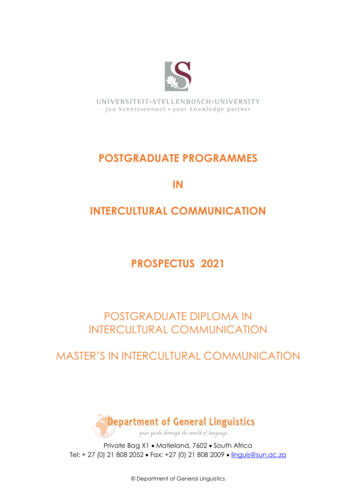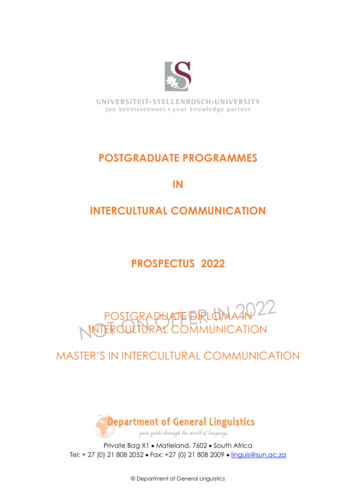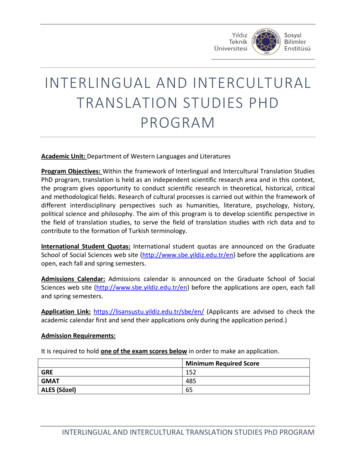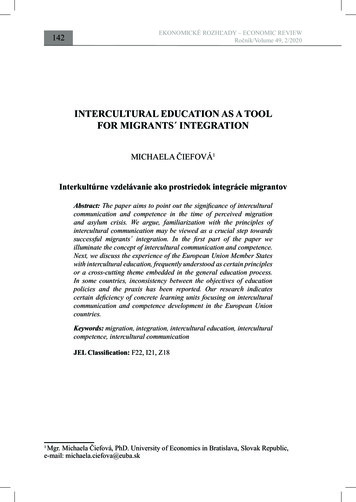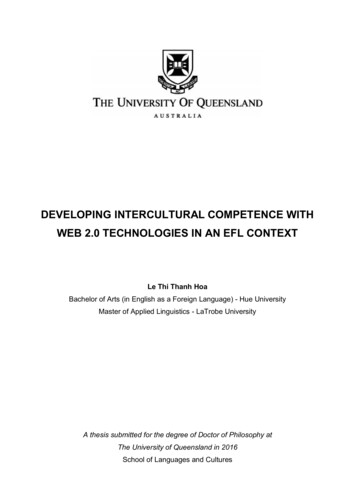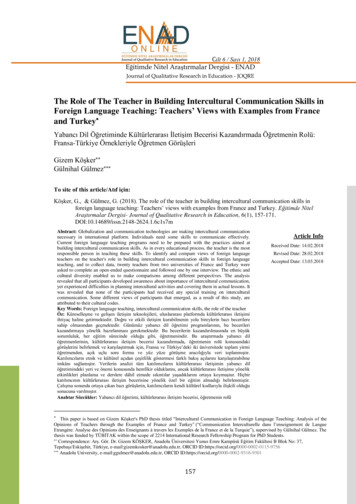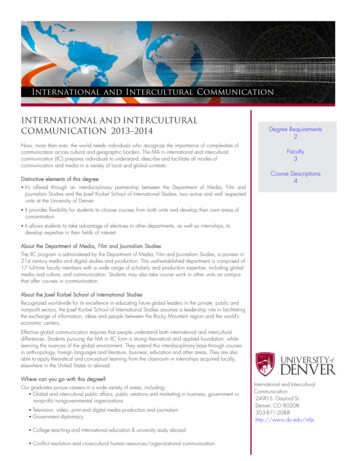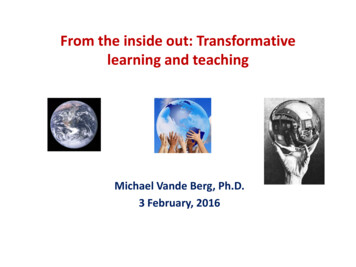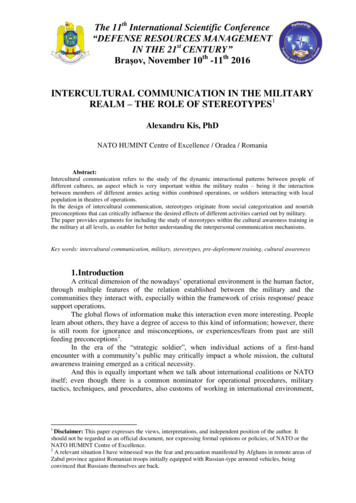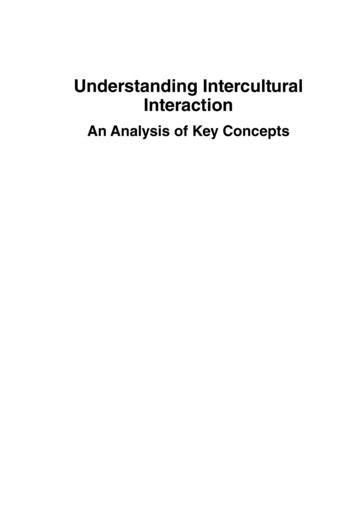
Transcription
Understanding InterculturalInteractionAn Analysis of Key Concepts
This page intentionally left blank
Understanding InterculturalInteractionAn Analysis of Key ConceptsFrank FitzpatrickUnited Kingdom – North AmericaJapan – India – Malaysia – China
Emerald Publishing LimitedHoward House, Wagon Lane, Bingley BD16 1WA, UKFirst edition 2020Copyright 2020 Frank FitzpatrickReprints and permissions serviceContact: permissions@emeraldinsight.comNo part of this book may be reproduced, stored in a retrieval system, transmitted inany form or by any means electronic, mechanical, photocopying, recording orotherwise without either the prior written permission of the publisher or a licencepermitting restricted copying issued in the UK by The Copyright Licensing Agencyand in the USA by The Copyright Clearance Center. Any opinions expressed in thechapters are those of the authors. Whilst Emerald makes every effort to ensure thequality and accuracy of its content, Emerald makes no representation implied orotherwise, as to the chapters’ suitability and application and disclaims any warranties,express or implied, to their use.British Library Cataloguing in Publication DataA catalogue record for this book is available from the British LibraryISBN: 978-1-83867-398-7 (Print)ISBN: 978-1-83867-397-0 (Online)ISBN: 978-1-83867-399-4 (Epub)
ContentsAbout the Author ixForeword xPart I: Approach and Principles Intercultural or Cross-cultural? Sites of Intercultural Interaction Key Themes – What is Culture? – Cultural Identity – Cultural Essentialism – The Universality of Culture – The Question of Cultural Relativism – Context and Power – Beyond Culture Towards Interculturality How the Key Concepts are Organised How to Use This Book 1334577889101113Part II: Key Concepts 15Acculturation 17Anxiety Uncertainty Management (AUM) Theory 21Attribution Theory (AT) 24Chinese Values Survey (CVS) 27Communication Accommodation Theory (CAT) 30Computer-Mediated Communication (CMC) 33Conversational Constraints Theory (CCT) 38Cognitive Dissonance Theory (CDT) 41Corruption Perceptions Index (CPI) 44Critical Intercultural Communication (CICC) 47Cross-Cultural Adjustment 50Cross-Cultural Attachment Theory (CCAT) 54Cross-Cultural Communication (CCC) 58Cultural Anthropology 61
viContentsCultural Context 64Cultural Dimensions 68Cultural Diplomacy 72Cultural Essentialism 75Cultural Hybridity 79Cultural Identity 83Cultural Imperialism 86Cultural Intelligence (CQ) 90Cultural Metaphors 93Cultural Paradigms 96Cultural Pluralism 100Cultural Relativism 103Cultural Stereotyping 107Cultural Studies 112Cultural Tightness Theory (CTL) 116Cultural Universals 120Culture and Ideology 123Culture and Power 126Culture and Tourism 130Culture Contact 134Culture Learning Theory (CLT) 137Culture Shock 141Culture Training 144Culturism and Cultural Otherising 148Democracy Index (DI) 151Developmental Model of Intercultural Sensitivity (DMIS) 154Ease of Doing Business Index (EDBI) 157Economic Freedom Index (EFI) 160Ethnocentrism 163Expectancy Violation Theory (EVT) 166Face Negotiation Theory (FNT) 170Global Competitiveness Index (GCI) 174Global Slavery Index (GSI) 177The GLOBE Studies 180E.T. Hall: The Silent Language 185Geert Hofstede: Software of the Mind 188Adrian Holliday: A Grammar of Culture 193Human Development Index (HDI) 197
ContentsviiIdentity Management Theory (IMT) 201Identity Negotiation Theory (INT) 204Individualism and Collectivism 207Integrated Threat Theory (ITT) 211Integrative Communication Theory (ICT) 214Interaction Adaptation Theory (IAT) 217Intercultural Communication (ICC) 220Intercultural Competence (IC) 225Intercultural Dialogue (ICD) 230Intercultural Literacy 233Interculturality 236Interdiscourse Communication (IDC) 239International Human Resource Management (IHRM) 242R.D. Lewis: When Cultures Collide 247Managing Cultural Diversity at Work (EDI) 250Managing Intercultural Teams 254John Mole: The Culture Triangle 258Multiculturalism 261Non-Verbal Communication (NVC) 265Organisational Culture 269Postmodernism 273Power Distance 277Rule of Law Index (RLI) 280Schwartz: Theory of Basic Human Values 283Social Identity Theory (SIT) 286Social Network Analysis (SNA) 289Social Progress Index (SPI) 292Socialisation and Enculturation 295Third Culture Identity (TCI) 298Time Orientation 301Fons Trompenaars: Seven Dimensions of Culture 304World Press Freedom Index (WPFI) 307World Values Survey (WVS) 310Worldwide Governance Indicators (WGI) 313Index 317
This page intentionally left blank
About the AuthorDr Frank Fitzpatrick is a highly qualified and accomplished international business leader, intercultural consultant and academic. For over 25 years he has workedas an intercultural specialist extensively across several continents in complex strategic environments, successfully promoting intercultural awareness and collaborationamongst diverse groups of people from different cultural backgrounds. He has a PhDin Cross-Cultural Communication and Master's degrees in Business Administrationand Linguistics.ix
ForewordThis book is aimed at students and professionals who wish to deepen their knowledge of how people interact in intercultural contexts by providing an overviewof key concepts from a breadth of perspectives. Living, working and studying inintercultural and international contexts is ever more relevant to everyone, whetheras language educators or students of social sciences, men and women working ininternational business and human resources or professionals dealing with issues ininternational relations and international development and specialist sectors such asindustry, diplomacy, health and education, among others. As education and workbecome increasingly international, every student and professional at some point islikely to feel the need to explore and discuss concepts of culture and identity in orderto be prepared for intercultural encounters in the globalised workplace, not least tounderstand themselves and the role that they play in their own society and on theinternational stage. For this, they will need the opportunity to be informed on and toexplore notions of culture and identity and how they relate to their lives and futurework. This book, then, brings together the most important and widely used conceptsand theories relating to intercultural interaction in an informative and accessiblemanner in order to enable students and professionals of all backgrounds to improvetheir knowledge and prospects for the future. This will enrich the experience ofintercultural interaction, improve the quality of business policies and dealings andbuild tolerance and understanding of different perspectives and conditions across theworld of work and study.x
Part IApproach and Principles
This page intentionally left blank
Intercultural or Cross-cultural?The terms intercultural and cross-cultural are both used in the concepts in this book, butthey are treated differently. Cross-cultural refers to comparative studies of behaviouracross different cultural settings, whereas intercultural refers to interaction betweenpeople from different cultural backgrounds within a particular context. For example, across-cultural analysis of how meetings are conducted might identify different formsof address, levels of formality or status, the use of non-verbal cues and so on, in different cultural contexts. However, an intercultural analysis would focus on how individuals from different backgrounds actually behave and interact with each other when theymeet and would analyse the outcomes of intercultural contact. In this sense, both levelsof scrutiny have relevance depending on the focus of analysis.The focus of this book is both intercultural and cross-cultural in that, on the one hand, itrefers to contexts where individuals and groups from a variety of cultural backgroundsand perspectives interact and navigate interculturality. This would include internationalbusiness contexts, situations of migration or international study and so on, where thereare perceived to be cultural differences in the way that people live, study or do business. However, there is also a cross-cultural focus in some of the concepts as they referto the processes involved in moving from one context to another or preparing for thismove, such as in cross-cultural adjustment or cross-cultural training. These conceptsalso create a link with issues in cross-cultural management, which has been prolificin generating an enormous volume of research, theory and practice for internationalbusiness situations, much of which is explained and critiqued in this book.The approach adopted in this book, then, draws upon concepts and theories across thespectrum and makes intercultural and cross-cultural concepts and issues relevant andaccessible to all groups of students and professionals, regardless of background. Itallows them to engage with the widest possible forum of contributors in their quest toposition themselves in the wider arena of intercultural studies. Above all, it is importantthat individuals from diverse backgrounds and interests have a common understandingand common language to be able to speak to one another and debate their point of view.Sites of Intercultural InteractionIntercultural encounters take place across a wide variety of sites, for many differentpurposes, involving people from many different backgrounds, and can be motivated bya number of factors. Engaging with others from different cultural backgrounds may bevoluntary, as in the case of international business people or professionals relocating forwork, or involve negotiating business transactions or students attending university inanother country. According to the reports of United Nations agencies, since 2009, the3
4Understanding Intercultural Interaction: An Analysis of Key Conceptsgrowth rate of trade in developing economies has almost doubled, increasing substantially in relation to that of developed economies to the extent that the value of tradeis now virtually equal in developing and developed countries as emerging economiesseek to catch up with wealthier ones in their share of global trade. Likewise, international education has seen spectacular growth. According to a recent report by theBritish Council, in the past ten years the number of internationally mobile HigherEducation students has risen from two million to over five million as countries seek tointernationalise their economies and societies. In addition to this, the United Nations’International Migration Report indicates that there are currently more than a quarterof a million migrants across the world, more than a 40% increase since 2000 and thehighest number ever.Other encounters may be due to enforced circumstances, as with refugees or asylumseekers seeking sanctuary. Intercultural contact may also be short term, as in the caseof tourism or international exchanges, or long term, as with permanent migration. Itmay also be inter-institutional where individuals represent a company, a governmentor a civic body, focussing on business, leisure, collaboration, diplomacy and so on, orit may be on an individual or casual basis. The vast range and variety of interculturalencounters has made the need for a greater understanding of intercultural behaviourincreasingly critical for everyone involved in global interaction.Intercultural interaction may also be remote, occurring digitally or through international communication and may be expressed in writing, through images or broadcastacross media. This means that there may be no direct contact with other people fromdifferent cultural backgrounds, but cultural representations and cross-cultural variations may be factors in interaction. This can be seen in such things as textbooks, films,music, fashion, ideas, ways of studying or doing business remotely and such, whichmay require adjustment and understanding of new, different worldviews in an increasingly globalised and postcolonial world in order for interaction to be successful.To reflect this considerable range of diversity and growth trends, the key conceptspresented in this book are designed to give insight into the multiple sites and contextsin which intercultural interaction takes place, drawing on research in context, in order toensure that students and practitioners benefit from the rich and diverse experience andknowledge that this brings. Whether working in industry, business, leisure, health, aid,defence, law and order or diplomacy, or studying or travelling as migrants, tourists orpractitioners, this book encourages readers to draw upon their own experiences in order tocontextualise the concepts presented and to enrich discussion from multiple viewpoints.Key ThemesUnderlying each concept there are meta-theoretical foundations or assumptions abouthuman nature, behaviour and knowledge that influence the way in which they are presented and explained. The breadth of study and research that contributes to analysinghow individuals and groups from different cultural backgrounds behave and interactnaturally creates an extensive panorama of analysis from a wide variety of perspectivesacross a range of disciplines, including language and communication studies, social
Approach and Principles5sciences and business and management studies. However, there are some recurrentthemes and issues that run through many of the concepts that readers may wish to beaware of and refer back to when analysing the concepts in Part II of this book.What is Culture?In the most general terms, given that humans are fundamentally social beings, culturerefers to what is created and shared between and among people, and all interaction andbehaviour can be seen to be framed and permeated by intercultural processes. As aresult, it is at the group level, however small or large, that culture needs to be analysedand understood. However, culture is often spoken about as if it were a pre-defined concept that has an external influence on us. We often talk, for example, of our nationalculture or the culture of an organisation, or the traditional culture of a community,and it is often associated with large constructs, such as civilisation or nationhood andexpressed through national cultural assets and symbols, such as music, literature orflags or national teams. Such a notion, which is heavily influenced by a positivist perspective that sees reality as objective and external to social interaction, tends to preyon the emotive appeal of national or ethnic identity, which invokes pride in one’s own‘culture’, and often, a sense of superiority in relation to others. Alternatively, culture isoften seen anthropologically, as a way of life in a particular, bounded location, relatingto traditions and customs, embodied in dress, cuisine, rituals, celebrations and so on,which provides continuity across generations and influences how individuals interprettheir world, how they behave and the choices that they make. Drawing on all of this,much contemporary management theory is based on identifying dimensions that seekto categorise and explain essential and, sometimes, seemingly irreconcilable characteristics, enshrined in national cultures, and to provide guidance for managers on how toovercome these differences and succeed in the intercultural arena.The notion that people in a nation make up a homogeneous ethnic, linguistic, or religious group can almost always be challenged, however. It is improbable, for example,that all members of any sizeable community know each other or necessarily share similar views on their commonalities, despite their sense of common identity being articulated through dominant religious, linguistic, historical, or other symbolic frameworks.Individuals will have different backgrounds, social and material means, experiences,aspirations, interests and levels of education, for example, as well as varying perspectives, allegiances and codes relating to their generation and social role, for instance.Furthermore, nations can be seen to be decidedly polycultural composites of smallerand diverse cultural groupings, while administrative and political arrangements basedin history have sometimes created cultural communities that may have become stateless and disparate, or have become hybrid versions that have evolved over generationsand through diaspora, as nation states have come and gone. Likewise, the idea thatindividuals and institutions interact and operate exclusively within a national borderor geographically bounded space is largely flawed, as all systems and economies areincreasingly linked through transnational interconnections facilitated by technologyand global media through increasing globalisation. Thus, the sense of cultural homogeneity perceived in large communities can be said to be largely conceptualised, or imagined, through symbolic representation and the persuasive call to unity. It is certainlytrue that many individuals and groups choose to identify with such conceptualisationsand the associated process of cultural categorisation, believing them to represent their
6Understanding Intercultural Interaction: An Analysis of Key Conceptssupposed innate cultural heritage. However, the immense diversity, hybridity, mixing, connecting and redefining that is continually evolving through persistent diaspora,fusion, bricolage and global change thwarts the simplistic association of places withfixed identities at any one particular time in history. Furthermore, culture, viewed as aproduct of nationhood or a similarly large construct, also encourages the discourse ofcultural superiority over others, fuelled by incompatible worldviews and beliefs andimbued with a sense of intolerance and inevitable intercultural conflict.This is in contrast to a social constructionist perspective on intercultural encounters, where culture is seen as a complex and dynamic process, which is rooted in aninterpretivist viewpoint of how we use language and communication to interact withand interpret our social world. Thus, while there are observable aspects of daily lifecreated from prolonged and enduring cultural grouping in the way that people goabout their everyday lives and interact with each other, culture is seen as an activeand negotiated process, rather than a static, essential quality related to pre-definedcategories. In this sense, culture will mean different things to different people. Thisperspective draws substantially on the notion of discourse, where language use permeates the day–to-day construction of meaning in context through an interpretiveframework and common intercultural processes. In this sense, there are establishedexpectations and generic conventions that regulate what should happen and what isappropriate in certain situations or cultural spaces, whether at work, in public andprivate life or in education and so on. Such cultural conventions influence socialroles, status and acceptable behaviour, and in intercultural interaction, if we lackknowledge of appropriate behavioural scripts and contextualised cues, or genrespecific language what feels like cultural misunderstandings may occur.Cultural life, however, is inevitably set within a framework of authority and powerrelations that govern and regulate a particular social and economic order, both fromthe wider institutional organisation of society and from the informal responses to theway individuals and groups resolve everyday issues at the discourse level. This addsa further dimension to the social constructionist approach, bringing into focus thedynamics of power and conflicting agendas, which permeate the purely constructiveand interpretive process and negotiation of meaning. In this sense, a dialecticalapproach, one of opposing and contradictory forces and interests pitched againsteach other, based in critical theory, becomes apposite when examining interculturalsituations, as it acknowledges the relational tensions that larger sociocultural constructscan yield.The approach to culture in this book, then, draws upon an interpretive perspectiveand embraces its complexity and its vitality while recognising, at the same time, thatthe administrative and sociocultural and political frameworks of formalised territories,along with their associated nationalist discourse, frame social interaction and createrelational and dialectical tension in everyday life. While the motivation to adopt anation-state framework for understanding culture is undoubtedly compelling, as it promotes simplicity of analysis, explanation and action, it is crucial to adopt a deeper levelof inquiry and recognise that social experience and the cultural meaning attributedto it by individuals at group level is an integral part of social interaction and that itis influenced by the wider social, economic and political relationships in which it isframed. In this sense, students and practitioners are encouraged to critically interpret
Approach and Principles7concepts in relation to the cultural groups that they encounter through their experienceand to reflect on them in relation to the context of behaviour, rather than assuming preordained characteristics based on nationality or supposed ethnicity.Cultural IdentityAs with culture, while we are influenced by our upbringing and cultural and socialenvironment, cultural identity is not something that we are merely given or need to discover within ourselves. While, initially, we are born into and live in a social order andway of life which existed before us and we learn a language and interact within institutional and social relationships that ascribe identities and roles to us through culturalrepresentations and categories, our identity is not determined by this. We may experience a sense of belonging or identification, but our identity is largely a combination ofhow we see ourselves and who we believe we are, on the one hand, and how others seeus and influence the way we are, on the other. In this sense, identity is personal, socialand cultural, and we construct it through interaction across multiple discursive sitesand settings influenced by the people that we know, the spaces and institutions that wefrequent and the narratives that we draw upon and identify with over time. We are all,at the same time members of multiple groups relating to the social roles that we play,whether, for example, as a family member, as an employee or as part of a particulargeneration, profession or society and so on. We are not defined by any one group, butour sense of identity is an amalgamation of all these roles and, as individuals, somewill have more influence on us than others. However, though we are able to makechoices about how we view ourselves as an individual and in relation to other people,where we are born and how we live constrains the amount and type of social, economicand cultural resources we have at our disposal to create our own biography or narrative.Thus, our life chances and our worldview will be influenced by the political, economicand sociocultural constraints of the cultural groups and society that we engage with.Cultural EssentialismSeeing culture and identity as objective and having a fixed nature with pre-definedcharacteristics that are inherent and static is known as cultural essentialism, rootedin a positivist approach that seeks to gather empirical evidence of the supposed ‘real’nature of cultural and social categories. Such a perspective also tends to be appliedto other social categories and roles, such as race or gender or nationality, in whichindividuals from a certain background are assumed to be alike or determined by theiressential nature, creating the idea of homogeneity across large populations or typesof people and predictability in how they may behave or interact. Much of this is notbased in evidence, however, but a result of acquired stereotypes or commonly held,imagined views drawn from prejudice or anecdotal accounts of purportedly typicalbehaviour. In this book, culture and identity are treated in a non-essentialist way, froman interpretive or subjective perspective that assumes that they are created and negotiated by individuals in a social context across multiple sites and locations throughinteraction. This does not exclude external influences on individuals, such as previously formed shared meaning, tradition, national symbols and values, popular mediaand literature and so on, which people may choose to identify with, albeit, in somecases, without critical reflection, but it does not accept enculturation or socialisation as determining factors. The increasing proliferation and diversification of relationships, spaces and sites of intercultural interaction, and the increasing range of
8Understanding Intercultural Interaction: An Analysis of Key Conceptstechnological resources and media for international connectivity, communication andmobility prevents a simplistic identification of individuals with stable and static identities based on a fixed location or social role. As a result, readers are encouraged tosee culture as fluid and to explore both the contextual constraints on and individualresponses to intercultural interaction.The Universality of CultureWhile culture is integral to human interaction, there are different views as to howmuch cultural variance occurs across different contexts and populations. An absolutist perspective, on the one hand, sees all human behaviour as species-related,regardless of cultural context. This means that all psychological constructs, such asintelligence or self-esteem, are displayed in the same way in all populations withno qualitative difference governed by cultural bias. In contrast to this is a relativiststandpoint, which assumes that most human behaviour is shaped and motivated byvalues and interpretations particular to specific cultural groups and contexts. Thismeans that certain behaviours, for example, may be valued or admonished in different ways across different cultural contexts, giving rise to variations in aspects ofsociocultural organisation.In moderation to these contrasting views, is a universalist approach, which contendsthat all biological and cognitive processes are common to all human beings as members of the same species and that we are able to interpret the behaviour of other humansregardless of cultural variance, although this may be displayed in different ways as aresult of cultural influences. Thus, for example, while such rites as birth, marriage, orcoming of age tend to be celebrated across all cultural groupings, the way that theyare practised tends to vary and we may have to learn about how this unfolds in different contexts. In this sense, the approach adopted in this book takes the view thatmany aspects of human behaviour can be considered common and universal acrossthe intercultural spectrum, and the concepts presented in Part II encourage readers toconsider those commonalities across different cultural contexts. This involves takinginto account how interculturality is created and sustained through interaction withinparticular contexts and encounters among individuals and groups, rather than assuming that behaviour is governed by pre-defined and essential cultural differences.The Question of Cultural RelativismThe question of cultural relativism frequently comes to the fore across the key concepts in this book because of the sensitivities that surround the debate on moralityand values, particularly when discussing critical social issues that lead to inequalityand vulnerability. While many aspects of culture can be considered universal, in thatthey relate to common patterns in how humans live together and interact, the criticalquestion is to identify what behaviour is universal and what is culture-specific. Forexample, all groups and societies tend to have some sort of structure, hierarchy androles, but the way that they are organised will differ substantially across the culturalspectrum. Some groups may have complex and multiple roles in the way that theyorganise themselves, for instance, while others may depend on simple and minimaldifferentiation or layers. Likewise, within communication, the existence of functions, such as greetings and non-verbal cues, or the use of prosodic features, such asvoice tone and stress, are universally common, but vary in their manifestation and use
as an intercultural specialist extensively across several continents in complex strate-gic environments, successfully promoting intercultural awareness and collaboration amongst diverse groups of people from different cultural backgrounds. He has a PhD in Cross-Cultural Communication and Master's degrees in Business Administration and Linguistics.
